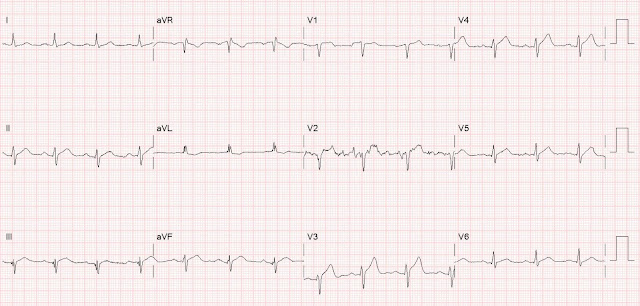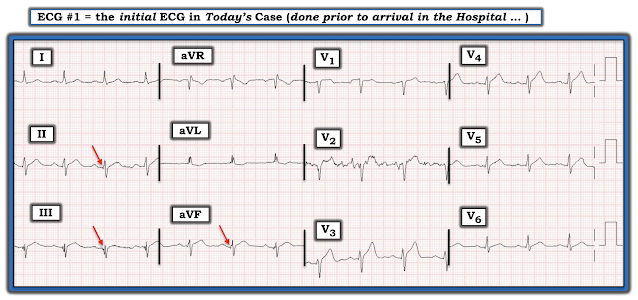Written by Pendell Meyers
EMS called in while I was on shift and asked me to review an ECG of a man in his 50s with acute chest pain and dyspnea that started approximately 45 minutes prior to arrival.
Here it is:
 |
| What do you think? |
We activated the cath lab because this is diagnostic of LAD OMI. There is sinus rhythm with normal QRS complex except slightly sluggish R wave progression (this is due to acute LAD OMI, diminishing the R wave voltage in its distribution). We see STE in V2-V4, and a hint of STE in II, III, and aVF. Hyperacute T waves are present in V2-V4, and II, III, and aVF. The T waves in V5 and V6 could also be increased in size and area compared to baseline, but no baseline was available.
There is a small amount of reciprocal STD in aVL (reciprocal from lead III), as well as a reciprocally negative T wave which is inappropriate for that QRS.
This is diagnostic of acute transmural infarction of anterior, lateral, and apical LV areas. The most common, important, and treatable etiology would of course be OMI until proven otherwise by emergent angiogram.
The OMI findings are not at all diffuse, rather focal exactly to the areas listed above. Posterior leads, if obtained, are likely to show reciprocal STD. (Or it might be too far away and with too much interposed lung to register any reciprocal STD)
Three providers disagreed and unanimously agreed that there was "no reciprocal findings", and one of them agreed with the computer's interpretation seen here:
First, and most important: anterior, lateral, and inferior ST Elevation is still far more likely to be OMI than pericarditis. Pericarditis is rare; OMI is common. And for this reason, "you diagnose pericarditis at your peril."
Look how the computer lists the criteria that led it to diagnose pericarditis: "ST >0.10 mV, ant/lat/inf." The computer, like most providers with average ECG education, is literally programmed to say that any ECG finding present in the anterior, lateral, and inferior leads is"diffuse."
Diffuse implies that the finding is present in all walls of the LV, meaning it must include at least all of the following areas of the LV: anterior, lateral, posterior, and inferior.
On this standard 12-lead ECG, there is Absence of diffuse ST elevation. In fact, there is reciprocal ST depression in aVL! Bischof and Smith showed that this does not happen in pericarditis, and happens nearly universally in inferior OMI. https://www.sciencedirect.com/science/article/abs/pii/S0735675715008189
Moreover, the standard 12-lead does NOT record posterior leads. Thus, it is not possible to determine whether a finding is diffuse on a standard 12-lead ECG, because we do not have posterior leads. If a patient had acute STE in V1-V6, I, aVL, II/III/aVF, and V7-9, then I suppose it could truly be described as diffuse, since it is present in all major LV walls.
Poh et al. showed that diffuse STD of subendocardial ischemia results in STD of all walls; therefore, it stands to reason that the diffuse STE of pericarditis (if the pericarditis/myocarditis is diffuse and not localized, as it usually is) would result in diffuse STE of all walls. Poh K-K, Chia B-L, Tan H-C, Yeo T-C, Lim Y-T. Absence of ST elevation in ECG leads V7, V8, V9 in ischaemia of non-occlusive aetiologies. Int J Cardiol [Internet] 2004;97(3):389–92. Available from: http://dx.doi.org/10.1016/j.ijcard.2003.10.022
One important problem is that normal ECG teaching does not include the following key points:
1) Many obvious STEMI(+) LAD OMIs do not have any reciprocal ST depressions.
2) Many LAD OMIs cause STE and hyperacute T waves in the inferior leads, which is usually attributed to apical LV involvement registering in the inferior leads. The LAD may also supply some of the inferior septum, which is part of the inferior wall, where the LAD territory meets the RCA territory.
3) Even in the LAD OMIs that do cause OMI findings in the anterior, lateral, and inferior leads, that is NOT "DIFFUSE" by definition unless you prove that the findings are also present in the posterior leads.
4) Pericarditis (without myocarditis, effusion, etc.) is an almost useless diagnosis to make, and is incredibly risky to make when ACS and OMI are a possible alternative etiology to the patient's symptoms.
This problem is yet another way that that the posterior wall is treated as is if doesn't exist. Posterior OMIs are among the most missed, and the posterior wall doesn't seem to count in the typical teaching of "diffuse ECG findings."
When he arrived in the ED, he looked extremely ill, extremely uncomfortable, pale, diaphoretic, and I was worried he would suffer cardiogenic shock or VF arrest before I could convince cardiology.
Here was his initial ED ECG:
 |
| To me this is an obvious STEMI(+) OMI. But I was told it "doesn't meet criteria" in real time. |
From the serial ECGs you can see that a large amount of anterolateral territory is either lost or stunned, and yet the deepening reperfusion T waves in those leads suggests that there was also a significant amount of myocardium that is hopefully undergoing the reperfusion process.
Learning Points:
Many LAD OMIs do not have noticeable reciprocal findings on the standard 12-lead ECG, because they can have STE and hyperacute T waves in the inferior leads. The case above was interpreted as having no reciprocal changes, but in fact there is reciprocal STD and TWI in aVL.
The troponin can be normal even in high sensitivity assays within the first few hours of symptoms. This is when the benefit of emergent reperfusion is maximal!
In my opinion, the term "diffuse" should not be used unless you have confirmed that the ECG finding is truly present in all major LV walls: anterior, lateral, posterior, and inferior. Anterior + lateral + inferior leads is still possibly quite focal - to the LAD. And a left main occlusion could affect all walls (though these patients usually do not get to the ED alive).
===================================
MY Comment, by KEN GRAUER, MD (2/9/2022):
===================================
Excellent post by Dr. Meyers — with an insightful series of 6 sequential tracings highlighting the evolution of the extensive infarction in today’s case. In the interest of academic discussion — I’ll play a bit of the “Devil’s Advocate” — by brief comment in defense of the term, “diffuse” — which I like and use on selected occasions..
I’ll emphasize that my use of the term, “diffuse” — is different I believe from the problematic use described by Dr. Meyers.
- First, the term, “diffuse” applied to ST elevation by Dr. Meyer’s definition (as I understand it) — should be reserved for the minority of cases that manifest ST elevation in anterior, lateral, inferior and posterior leads. But this may set up a difficult (if not impossible) situation to satisfy — because simultaneous ST “elevation” in anterior and posterior leads may result in an attenuation (if not cancellation) of forces, since acute posterior infarction manifests with anterior ST depression.
- As a result — I reserve use of the term, “diffuse” as a descriptor of generalized ST-T wave changes in virtually all leads except aVR (and on occasion, lead V1). The other way in which I use the term, “diffuse” different than I believe many other clinicians do — is to reserve my use of this word for when the changes I am describing (ie, be this ST elevation, ST depression, or “diffuse” ST flattening) — for when these ST-T wave changes look very similar in at least 8-9 leads. This is not what we see in the 1st ECG from today’s case (which for clarity, I have redrawn in Figure-1).
- P.S.: How much ST elevation or depression in one anatomic area of the heart attenuates (or cancels out) the opposite ST segment response in an opposing area of the heart is difficult to predict due to a series of variables (including which, how many, and how severe involvement is in other coronary arteries).
 |
| Figure-1: The initial ECG in today’s case, obtained approximately 45 minutes prior to hospital arrival. |
NOTE: I agree completely with Dr. Meyers that the initial ECG in today's case ( = Figure-1) in this patient with new-onset chest pain — is diagnostic of an acute OMI in need of prompt catheterization. I also agree with Dr. Meyers that the ST-T wave changes seen on this tracing are not “diffuse” because:
- 2 of the 12 leads show much more emphatic acute findings than the other 10 leads (ie, significant ST elevation with “voluminous” hyperacute T waves in leads V3 and V4 that are decidedly taller than the R wave in these respective leads).
- There is too much artifact in lead V2 to ascertain what the ST segment in this lead is doing.
- The 3 ST segments for the 3 beats seen in lead V1 all look different — so I have NO idea what the “real” ST segment in lead V1 looks like.
- Leads V5 and V6 could clearly also be hyperacute— but the amount of ST elevation in these leads is modest at best — and height of the T waves in these leads, respective to the R wave is not nearly as impressively increased as it is for the T waves in leads V3 and V4.
In the limb leads:
- There are subtle-but-real Q waves with initial notching in each of the inferior leads that strongly suggest infarction at some point in time (RED arrows in Figure-1). But in the absence of a baseline ECG for comparison — I am not convinced that these inferior Q waves are “new” (ie, perhaps this patient had a prior inferior MI).
- True — the ST segments in each of the inferior leads manifest a “straight” takeoff (if not a hint of ST elevation with ST coving) — and — the shallow T wave inversion in lead aVL is clearly the mirror-image of the ST-T wave in lead III. But these changes are relatively modest compared to the ECG picture in leads V3 and V4.
- Finally — I see nothing “acute” about the ST-T wave in lead I.
CONCLUSION: I completely agree with Dr. Meyers that ST-T wave changes in this initial ECG shown in Figure-1 are definitely not “diffuse”.
- The “beauty” of medicine — is that there is often more than a single appropriate answer or approach to any clinical situation. As a result — I choose to continue my use of the term “diffuse” for those selective situations that I describe above.






No comments:
Post a Comment
DEAR READER: I have loved receiving your comments, but I am no longer able to moderate them. Since the vast majority are SPAM, I need to moderate them all. Therefore, comments will rarely be published any more. So Sorry.